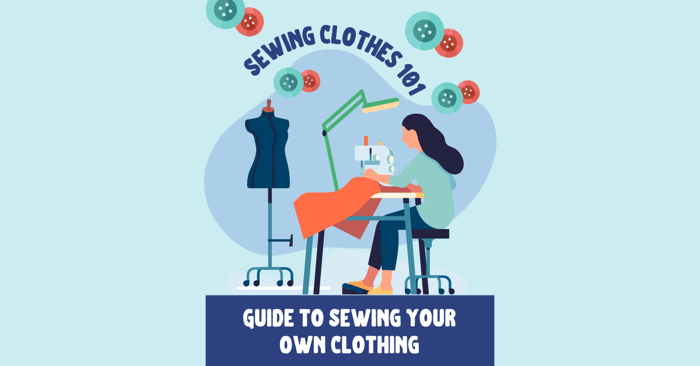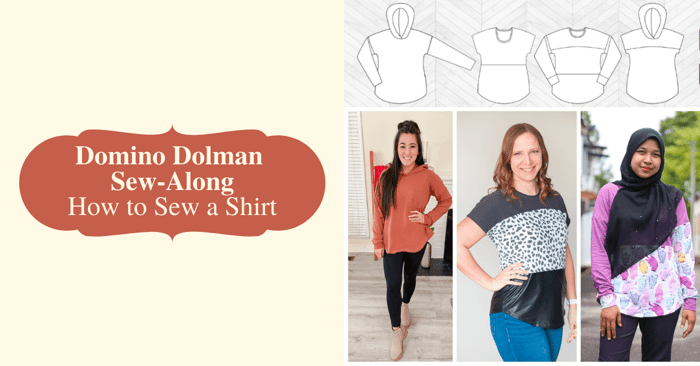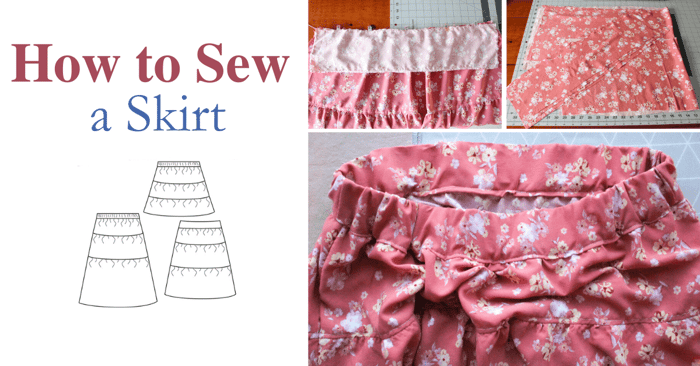
Sewing Clothes | Guide to Sewing Your Own Clothing
Sewing clothes is what we do around here. It's a timeless craft that allows you to express your creativity and create unique, one-of-a-kind items for you, your kids, relatives, friends...maybe even your husband. It's also not as hard as you might think. Our step-by-step sewing patterns with photographs and illustrations make sewing clothes fun. From selecting the perfect fabric to mastering different stitching techniques, every step of the process is an opportunity to learn and grow as a sewist.
Not only does sewing clothes give you the freedom to customize your wardrobe to suit your personal style, but it also allows you to create garments that fit you perfectly. With some patience and practice, you can turn your sewing machine into a tool for self-expression and create fashionable and functional garments. So why settle for store-bought when you can sew your clothes?
Today we're going to share a round-up of some of our favorite blog posts throughout the years that will help you get started sewing. Whether you’re just getting started or are a seasoned sewer, these techniques will help you create garments that fit you perfectly and look professionally made. So grab your sewing machine, and start creating beautiful, custom-made clothing!
Sewing Clothes | Why Should I Sew My Own Clothing
Our customers love sewing their own clothing! Here are a few reasons:
- Custom Fit: When you sew your clothes or clothes for the ones you love, you can ensure that they fit perfectly. Many people struggle to find clothes that fit well in the store.
- Personal Expression: When you create your own clothing, you can express your style and create one-of-a-kind garments.
- Sense of Accomplishment: A sense of accomplishment comes from creating something with your own hands. Sewing is a rewarding hobby!
- Customizable: If you can’t find a piece of clothing with all the features you want, you can make it yourself.
Learning to sew clothes is a fulfilling and straightforward skill that anyone can acquire with a little practice. If you're interested in learning, several resources are available to help you get started. You can begin by taking online courses or watching instructional videos on YouTube or other platforms. Alternatively, you can learn from books or join a local group for hands-on guidance and support. Sewing clothes allows you to create custom pieces that fit your unique style and body type while also providing a sense of accomplishment and self-sufficiency.
Sewing Patterns | What Kind of Sewing Patterns Should I Start With
We specialize in beginner-friendly patterns for sewing clohtes. These patterns can be downloaded and printed at home - you can even just print the pattern piece for the size that you want. These "PDF Patterns" have exploded in popularity over the last 10 years or 15 years and are popular among sewers for many reasons:
- Convenience: PDF patterns can be downloaded and printed immediately.
- Variety: You have wide access to hundreds of patterns. We have around 300 at Peek-a-Boo.
- Cost-effective: PDF patterns are often less expensive than printed patterns.
- Space-saving: PDF patterns take up less physical space than printed patterns, and you can easily store them on your computer or tablet. As noted in the post below, you can also use them with a projector.
- Good Fit: You can easily get the right fit by looking at the patterns size chart.
- Customizable: Some PDF patterns have layers, meaning you can print only the size you need, or you can adjust the pattern to your liking.
PDF patterns are a great option for both beginners and experienced sewers. You'll love the step-by-step instructions, color photos, optionality, and more. For more information, take a look at some of the articles below.
What are some beginner-friendly patterns for sewing clothes?
Some beginner-friendly patterns for sewing clothes include simple T-shirts, elastic-waist skirts, and basic shift dresses. These patterns typically have few pieces and minimal complicated techniques, making them perfect for those new to sewing. Here are a few options:
Sewing Vocab
If you're a beginner at sewing, you should know some basic concepts and vocab (more than just what a tape measure is) before starting your first project. One of the most important things to grasp is standard terminology and vocabulary, which will help you follow instructions and understand tutorials. If you don't know terms like seam allowance, bias tape, hem, fold line, or backstitch then you should take a minute to get up to speed. To help you out, we have a helpful article on sewing terms that can serve as a valuable resource.
Sewing Machines & Tools
Having the right machines and tools is crucial for sewing clothing. The quality of your equipment can greatly impact the outcome of your projects. A good machine with various stitching options, buttonhole ability, and adjustable settings allows for precise and professional-looking seams. It should also have a range of built-in features such as automatic needle threading, adjustable stitch length and width, and a variety of presser feet. In addition to a reliable sewing machine, other essential tools include sharp scissors, measuring tape, seam ripper, pins, and thread. These tools ensure accurate measurements, clean cuts, and secure stitching.
If you are serious about making clothing, you should also consider investing in more advanced machines. A serger is particularly important and as you progress you might get a coverstitch machine to enhance your topstitching. Investing in high-quality machines and tools can enhance your skills and create beautifully crafted garments that will stand the test of time.
Basic Sewing Skills to Learn to Seam, Stitch, and Hem
After acquiring the necessary machines and tools, learning some fundamental sewing skills is all that's left to start creating your own clothing. Familiarizing yourself with different types of stitches, techniques, and fabrics can help you develop the skills needed to create high-quality garments. By practicing these basic skills, you can gradually improve your abilities and begin experimenting with more advanced techniques. With time and patience, you can become proficient in sewing and even turn it into a rewarding hobby or career.
From learning how to sew on a button, to learning how to make a seam, and more, here are a few articles to get your started:
Sew Alongs
Whether it's your first time with a beginner-friendly pattern or you've been sewing for a long time, it can be beneficial to have guidance from someone else. That's why we provide sew-along posts where experienced seamstresses take our patterns and guide you through the process step by step. These sew-alongs are a great way to learn new techniques and gain confidence in your abilities. Plus, they offer a sense of community and support as you work on your projects alongside other sewists. Whether you're a beginner or an experienced sewer looking to try out a new pattern, our sew-alongs are a valuable resource for anyone looking to improve their skills. Here are a few of our favorite sew-alongs:
Apart from these sew-alongs, we are also on YouTube. Our YouTube channel will take you step-by-step through a number of our popular patterns making the process even easier.
How to Sew…..Some Advanced Techniques
For experienced sewists who want to elevate their sewing game, we offer various informative posts covering advanced techniques. These techniques are designed to help you create more intricate and complex projects with precision and finesse. From mastering the perfect hemline to inserting invisible zippers, our advanced technique guides will take your skills to the next level.
We also provide helpful tips on choosing the right fabrics, threads, and needles for your projects to ensure that your final product is of the highest quality. Whether you want to sew garments, home decor items, or accessories, our advanced technique posts have covered you. Here’s a small sampling:
Sewing Accessories
Making accessories for your wardrobe or as fun additions to your children's playtime is a great way to start sewing clothes. There are many accessories that you can create, such as scarfs, hats, gloves, and bags. You can also add personal touches to your creations by incorporating different patterns, colors, and textures.
By exploring different techniques and experimenting with fabrics, you can create unique and stylish accessories that are perfect for any occasion.
Choosing Your Garment Fabric
Choosing the right fabric is a crucial step in making clothes that not only look good but also feel comfortable to wear. Getting the right fabric is a crucial step in ensuring that your garments look professionally done. The type of fabric you choose can greatly impact the overall appearance and quality of your finished piece.There are several factors to consider when selecting fabric, such as the type of garment you're making, the desired drape and texture, and the level of care required. For lightweight and flowy garments like dresses or blouses, natural fabrics like cotton or silk are often a popular choice due to their breathability and softness. On the other hand, if you're looking for more structure and durability, fabrics like denim or twill can be ideal for pants or jackets.
It's also important to consider the seasonality of the fabric - opt for lightweight materials in summer and heavier ones in winter. Ultimately, finding the perfect fabric for your project requires careful consideration of both look and functionality. So take your time, explore different options, and let your creative vision guide you toward creating garments that are truly unique and tailored to your style. Luckily, we have a handy fabric guide to help you decide exactly which fabric is right for your clothing project.
Sewing Knit Fabric
Sewing knit fabric can enhance your clothing options, and at Peek-a-Boo, we are passionate about it. Our sister website, KnitFabric.com offers high-quality fabrics for apparel at competitive prices with flat-rate shipping. By providing customers with excellent quality knit fabrics, we enable them to expand their creative horizons and create unique garments that stand out. With our comprehensive range of knit fabrics, including cotton lycra, French terry, and rib knits, we strive to provide the best possible products and service to our customers. Whether you're a seasoned sewist or a beginner, we have everything you need to create beautiful clothing pieces.
Sewing with knit fabric requires some adjustments compared to using woven fabric. Due to its stretchy nature, it is essential to use specialized techniques such as a walking foot or a serger. These tools can help prevent the fabric from puckering or stretching out of shape during sewing. If you are new to sewing with knit fabrics, there are several helpful articles available online that can guide you through the process and provide useful tips and tricks. With practice and patience, you can master the art of sewing with knit fabrics and create comfortable and stylish garments for yourself or your loved ones.
Sewing a Swimsuit
Sewing clothes is a wonderful hobby that opens up endless possibilities, including creating your own swimsuits. Making your swimsuit has several benefits, such as providing a custom fit that perfectly suits your body type. It also ensures durability and allows you to use fun and unique swimsuit fabrics that reflect your personality. Perhaps the most satisfying aspect of making a swimsuit is the sense of accomplishment that comes with creating something entirely on your own. Additionally, making your swimsuit can be cost-effective in the long run, especially if you plan to sew more than one swimsuit. With some practice and patience, making a swimsuit can be an enjoyable experience that allows you to express your creativity while building a functional piece of clothing.
Making Your Clothes Look Professionally Done
Making your clothes look professionally done is all about attention to detail and precision. Additionally, taking accurate measurements and making muslins or test garments before cutting into your final fabric can help you achieve a perfect fit. Paying close attention to small details such as matching patterns, properly finishing seams, and using appropriate stitching techniques will also elevate the overall look of your garment....that being said, you'll be surprised how easy it is to make clothing that looks professionally made...all you need is the right tools and a little bit of practice.
We hope you found today's information on making clothes informative and helpful. As mentioned earlier, making your own clothes comes with many benefits, such as customization, cost-effectiveness, and sustainability. Before you leave, we invite you to join our Peek-a-Boo Pattern Shop Facebook Group where you can connect with fellow sewing enthusiasts and get guidance and support for your projects. Our community is a great place to share your creations, ask questions, and learn new techniques. Also, come follow us on Instagram. We look forward to seeing you there!
Good luck in your sewing journey!

































